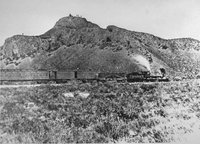Golden spike
|
|
- This article is about a historical event, for information on "golden spikes" in geology: See GSSP
The golden spike is the solid-gold railroad spike which was hammered in by Leland Stanford to commemorate the completion of the first transcontinental railroad in the world, when the Central Pacific and Union Pacific railroads met on May 10, 1869 at Promontory Summit in Box Elder County in the Utah Territory, now part of northern Utah.
| Contents |
History of the Event
The idea of completing the last link in the transcontinental railroad with a spike of gold was due to David Hewes, a San Francisco financier and contractor who was also Stanford's wife's brother-in-law. The spike had been manufactured earlier that year especially for the event by the William T. Garret Foundry in San Francisco. A special tie of pre-bored polished California laurel was chosen to complete the line where the spike would be driven.
Originally the ceremony was to be held on May 8, but it was postponed two days because of bad weather and a labor dispute that delayed the arrival of the Union Pacific delegation.
On May 10, in anticipation of the ceremony, the Union Pacific's No. 119 and Central Pacific's "Jupiter" locomotives engines were drawn up face-to-face on Promontory Summit, separated only by the width of a single tie. A crowd of over 3000 government and railroad officials and track workers was present to witness the event.
Before the last spike was driven, three other commemorative spikes, presented by the other three members of the "Big Four", had been previously driven in the pre-bored laurel tie:
- a second gold spike supplied by the San Francisco News Letter
- a silver spike supplied by the State of Nevada
- a blended iron, silver, and gold spike supplied by the Arizona Territory.
The absence of a spike from the Utah Territory, as well as the absence of Mormon officials, was considered conspicuous.
With the locomotives drawn so near, the crowd pressed so closely around Stanford and the other railroad officials that the ceremony became somewhat disorganized, leading to varying accounts of the actual events.
To drive the final spike, Stanford lifted a silver hammer and drove the spike into the tie, completing the line.
Immediately afterwards, the golden spike and the laurel tie were removed and replaced with a regular iron spike and normal tie. At exactly 12:47, the last iron spike was driven, finally completing the line. Stanford and Hewes missed the spike, but the single word "done" was nevertheless flashed by telegraph around the country. The event has come to be considered one of the world's first nationwide media events.
After the ceremony, Stanford gave the golden spike to Hewes, who in turn gave it to the Stanford Museum in 1892. The last laurel tie was destroyed in the 1906 San Francisco earthquake.
Aftermath
Although the Promontory Summit event marked the completion of the transcontinental railroad line, it did not actually mark the completion of a seamless coast-to-coast rail network. Because no railroad bridge yet existed over the Missouri River between Council Bluffs, Iowa, and Omaha, Nebraska, passengers were required to disembark there to cross the river by boat until 1872. The coast-to-coast rail network was completed in the meantime in August 1870 in Strassburg, Colorado by the completion of the Denver extension of the Kansas Pacific Railroad.
In 1942, the old rails over Promontory Summit were salvaged for war effort. The event was marked by a ceremonial "undriving" of the last iron spike. The original event had been all but forgotten, except by local residents who erected a commemorative marker in 1943. The years after the war saw a revival of interest in the event. In 1948, the first re-enactment was held.
In 1957, Congress established the Golden Spike National Historic Site to preserve the area around Promontory Summit as closely as possible to its appearance in 1869. The site also contains working replicas of the original locomotive engines present at the ceremony which are drawn up face-to-face each Saturday during the summer for a recreation of the original event.
Facts about the Golden Spike
- contains 17.6 carat (73%) gold, alloyed with copper
- total weight 14.03 troy ounces (436 g)
- has clearly visible nicks where Stanford drove it with the silver hammer
- has engraving on all four sides:
- "The Pacific Railroad ground broken Jany. 8th 1863, and completed May 8th 1869"
- "Directors of the C. P. R. R. of Cal. Hon. Leland Stanford. C. P. Huntington. E. B. Crocker. Mark Hopkins. A. P. Stanford. E. H. Miller Jr"
- "Officers. Hon. Leland Stanford. Presdt. C. P. Huntington Vice Presdt. E. B. Crocker. Atty. Mark Hopkins. Tresr. Chas Crocker Gen. Supdt. E. H. Miller Jr. Secty. S. S. Montague. Chief Engr."
- "May God continue the unity of our Country, as the Railroad unites the two great Oceans of the world. Presented by David Hewes San Francisco."
External links
- National Park Service: Cultural Landscape Report--Golden Spike National Historic Site (http://www.nps.gov/gosp/clr/clrt.htm)
- The Last Spike: Stanford University (http://www.stanford.edu/dept/SUMA/spike.html)
- Virtual Museum of the City of San Francisco: Driving the Last Spike (http://www.sfmuseum.org/hist1/rail.html)
- Fort Odgen web site showing re-enactment (http://www.fortogden.com/goldenspike.html)
- Utah History Encyclopedia (http://www.media.utah.edu/UHE/g/GOLDENSPIKE.html)

